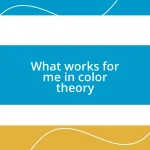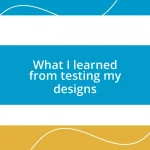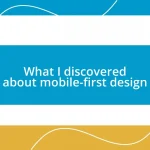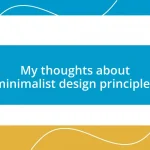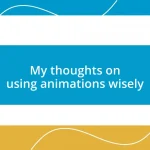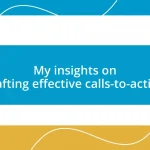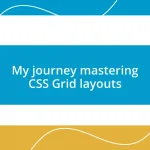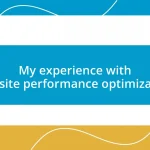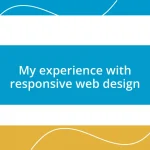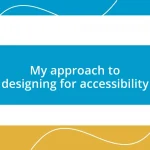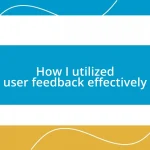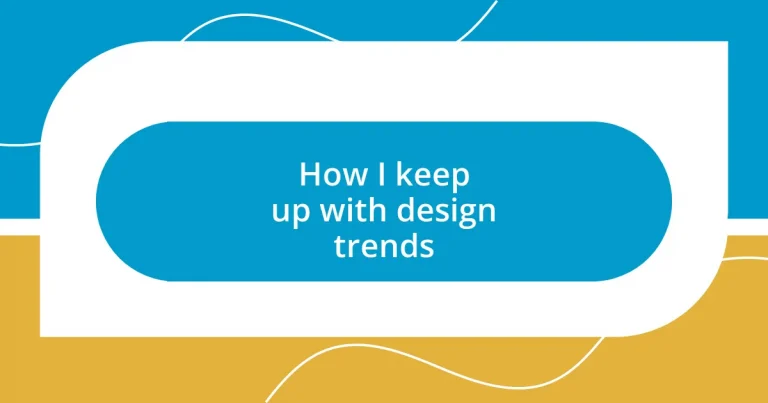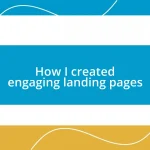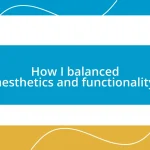Key takeaways:
- Design trends reflect cultural shifts and technological advancements, requiring a blend of awareness and intuition to create meaningful designs.
- Social media platforms and design newsletters are valuable sources of inspiration, showcasing emerging trends and diverse perspectives in the design community.
- Attending workshops and events fosters collaboration and personal growth, helping designers make lasting professional connections.
- Utilizing design software enhances creativity and efficiency, allowing designers to experiment with new techniques and ideas.
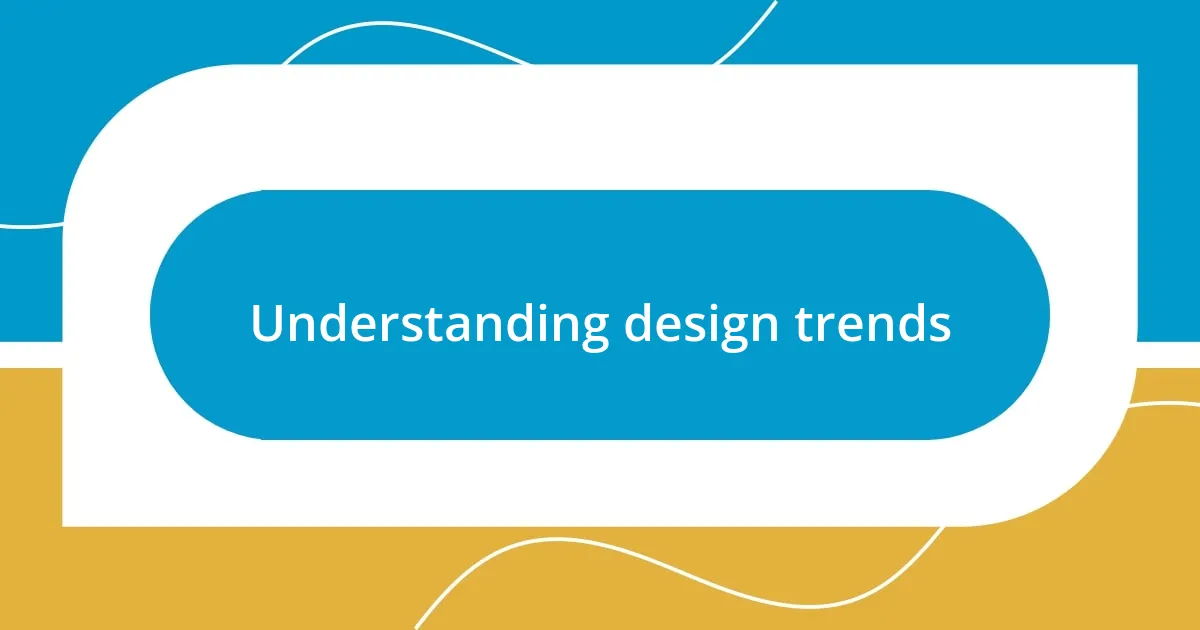
Understanding design trends
Design trends are more than just fleeting fads; they often reflect the cultural zeitgeist and technological advancements of our times. I remember the excitement I felt when minimalism took center stage a few years back. It resonated with my own desire for simplicity amidst the chaos of everyday life; how could you not appreciate a design that calmed the senses?
As I delved deeper into understanding design trends, I realized that they’re intricately linked to societal shifts. For instance, the rise of sustainable design echoes our growing awareness of environmental issues. Doesn’t it feel rewarding to incorporate eco-friendly materials into your work, knowing you are contributing to a larger purpose?
Engaging with design trends requires a balance of awareness and intuition. Sometimes, I find myself questioning what makes a trend truly resonate—Is it the aesthetic appeal, or does it tap into a deeper emotional connection? This blend of reason and emotion is what I strive to capture in my designs, ensuring that they are not only current but meaningful to those who experience them.
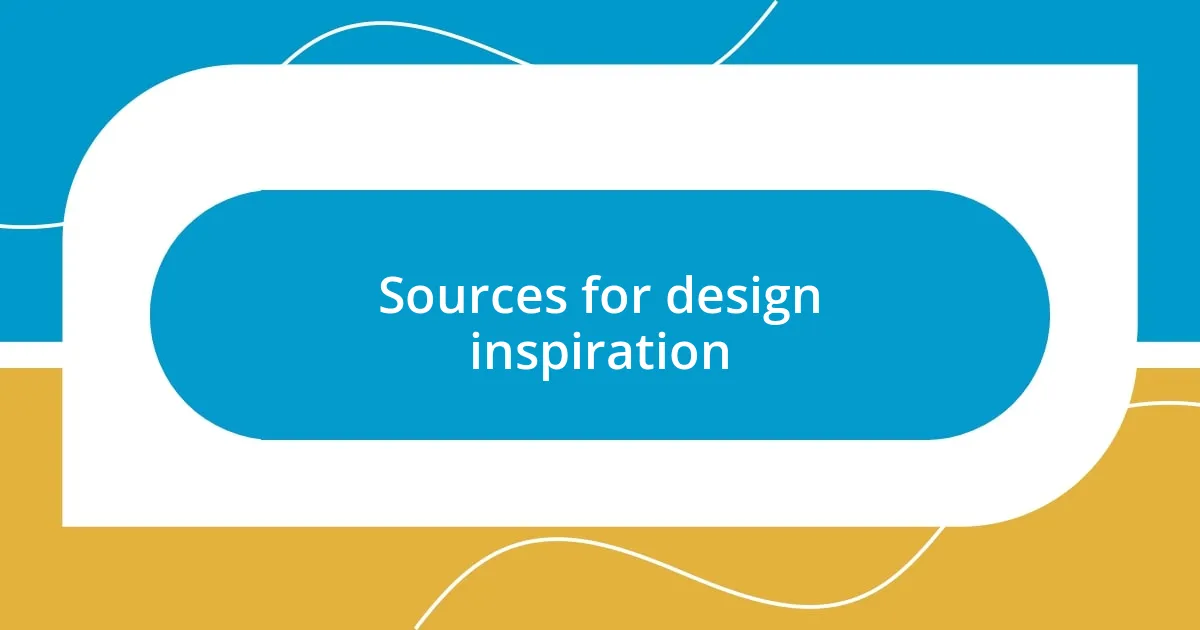
Sources for design inspiration
I find that exploring various sources for design inspiration fuels my creative process. Social media platforms like Instagram and Pinterest are treasure troves of visual stimulation. I remember scrolling through Instagram late one night and discovering a trend for biophilic design – incorporating natural elements into our spaces. That moment sparked my passion for blending the indoors with nature, and it has since transformed how I approach my projects.
Here are some key sources I often tap into for inspiration:
- Design Magazines: Publications like Architectural Digest and Elle Decor offer curated insights into the latest trends and innovative designs.
- Online Platforms: Websites such as Behance and Dribbble showcase the work of creative professionals, providing a glimpse of diverse styles and concepts.
- Nature: I love taking walks in local parks or gardens. The colors, textures, and forms I see can often translate into striking design elements.
- Art Exhibitions: Visiting galleries opens my mind to new artistic techniques and ideas that can influence design thinking.
- Workshops and Conferences: Engaging with other designers in person allows for real-time exchange of fresh ideas and perspectives.
Each of these sources not only inspires me but also challenges me to think outside the box, pushing my creative boundaries.
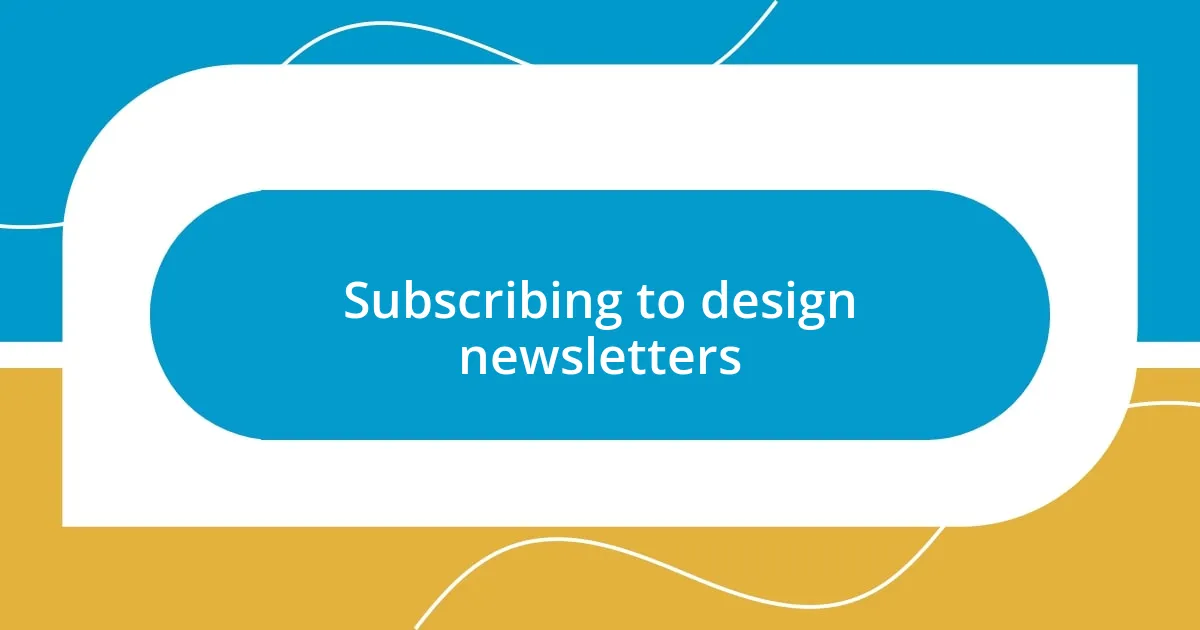
Subscribing to design newsletters
Subscribing to design newsletters has been a game changer for me in staying updated with the latest trends. I remember the day I signed up for my first design newsletter; it was like unlocking a treasure trove of information and inspiration. Every week, I receive curated content that not only showcases current movements but also dives into the stories behind the designs. It’s fascinating to see how each newsletter highlights different aspects of the design world, making it a delightful ritual I look forward to.
The beauty of design newsletters lies in their diversity. Some focus heavily on emerging trends, while others provide historical contexts or delve into case studies of iconic designs. For instance, I’ve come across newsletters that feature interviews with industry leaders. These personal insights often resonate with my own journey and challenges, reminding me that the pursuit of design is a shared experience. I find it refreshing to hear that even the most celebrated designers faced doubts and obstacles along the way.
Additionally, newsletters often include useful resources such as workshops, events, or tools that I may have missed otherwise. I clearly recall discovering an online webinar through a newsletter that greatly improved my skills in sustainability practices. That small nudge from the newsletter kept my learning alive and invigorated my passion for design. It’s amazing how a simple subscription can lead to such impactful growth and connectivity in the vast landscape of design.
| Newsletter Feature | Benefit |
|---|---|
| Emerging Trends | Stay updated on what’s popular |
| Interviews with Designers | Gain personal insights and inspiration |
| Case Studies | Learn from real-world applications of design |
| Event Alerts | Opportunities for networking and learning |
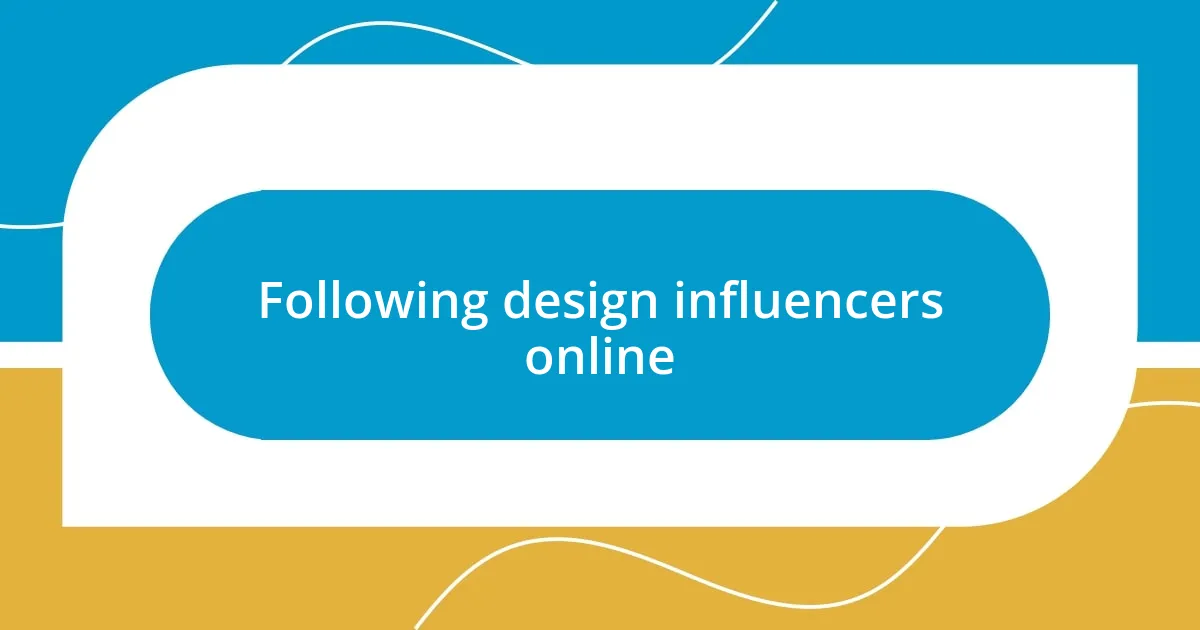
Following design influencers online
Following design influencers online has become one of my go-to strategies for keeping my design sensibilities sharp. I remember the first time I stumbled upon an architect’s Instagram, their architectural photography captivated me. It made me wonder: how can one feed their audience visually while telling a compelling design story at the same time? Observing the way influencers curate their feeds illustrates that good design is as much about aesthetics as it is about narrative.
Social media gives me access to a diverse range of perspectives I might not encounter otherwise. I find myself drawn to influencers who challenge conventional design norms, creating spaces that not only look stunning but also promote sustainable living. Just last week, a post from a sustainable design influencer completely wowed me. Their inventive use of recycled materials sparked the idea for my next project: why not integrate upcycled elements into my next design?
What I particularly love is the sense of community I’ve found while following these influencers. Through their stories, polls, and Q&As, I often feel like I’m part of a vibrant dialogue about design. I still recall the thrill of commenting on a design influencer’s post, expressing my admiration, and receiving a response. It’s fulfilling to know that in this digital age, sharing ideas and inspirations crosses borders, uniting creatives from all walks of life. Isn’t it inspiring how a simple click can connect us to innovative thinkers?
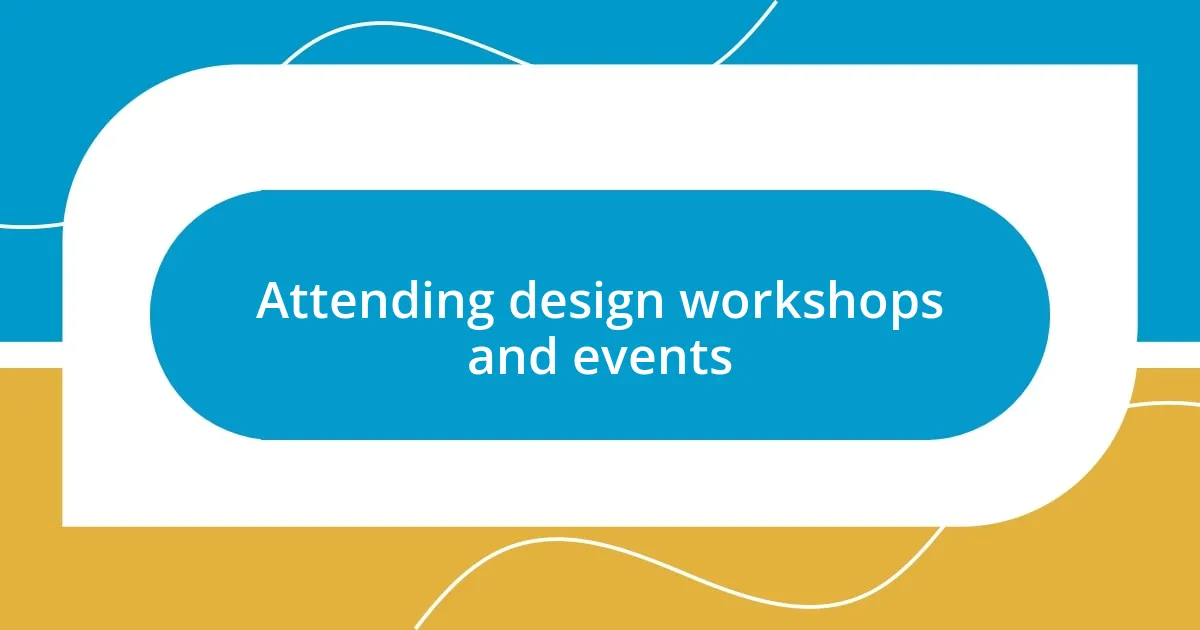
Attending design workshops and events
Attending design workshops and events has always been a key part of my journey in staying connected to the latest trends. I vividly recall my first workshop on user experience design; the energy in the room was palpable. Engaging with fellow designers, sharing ideas, and gaining hands-on experience invigorated my creative spirit in ways I hadn’t anticipated. The opportunities to collaborate and learn from industry experts face-to-face helped solidify concepts that I had only read about in articles.
There’s something special about the immediacy of in-person events. I remember attending a panel discussion where designers from various fields shared their insights on the intersection of technology and design. Listening to their stories — especially the challenges they faced — was both eye-opening and inspiring. It made me realize how vital it is to understand different perspectives in order to evolve as a designer. Have you ever felt completely energized by an idea shared in a room full of passionate individuals? That sense of belonging can be incredibly motivating.
Moreover, workshops often provide practical experience that is tough to replicate in an online setting. I once participated in a design sprint where we had to develop a solution within just a few hours. The rush of adrenaline and creativity was unmatched. It pushed me to think outside the box and collaborate effectively. I also cherish the connections I made during those events; some have blossomed into lasting professional relationships that continue to support my growth in design. It’s thrilling to think about how these shared experiences can shape our careers and cultivate a sense of community within the design landscape.
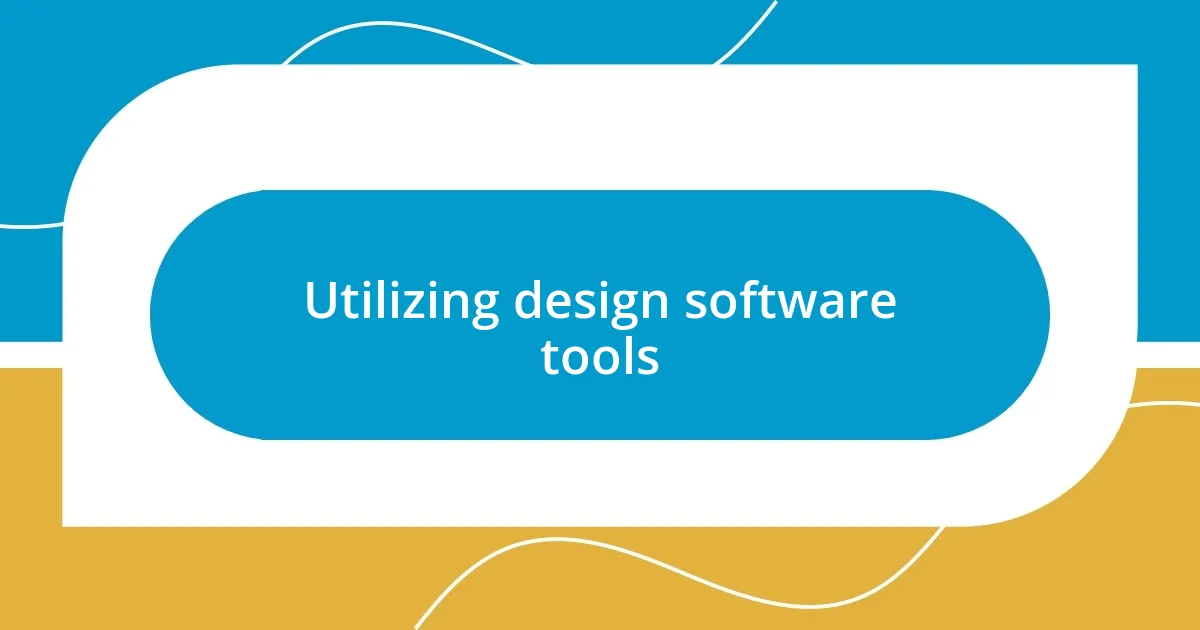
Utilizing design software tools
Utilizing design software tools has transformed my approach to honing my craft. I vividly recall the first time I opened Adobe Illustrator; the array of features felt overwhelming yet exhilarating. It was like stepping into a new world where I could take my ideas and watch them come to life with just a few clicks. How can something as simple as drawing lines and filling colors evoke such joy? For me, it’s the creative potential software affords that keeps my passion alive.
I have also found myself gravitating toward collaborative tools like Figma, especially during team projects. There’s an undeniable thrill when multiple minds brainstorm and design simultaneously on such a platform. I remember working on a tight deadline; the excitement in the air was palpable as we revised and iterated in real-time. Have you ever experienced that rush when a design concept shifts into something unexpectedly brilliant through team input? The energy from collaboration often sparks new ideas I hadn’t considered before.
As I explore these tools, I encounter tutorials and online courses that push my abilities further. Just last month, I stumbled upon a series of video lessons focusing on animation techniques in After Effects. The way those animations could bring static designs to life fascinated me! I quickly dove in, excited to experiment with my newfound skills. With each new feature I master, it feels like I’m expanding my toolbox, ready to tackle diverse projects with greater confidence. Isn’t it amazing how technology can enhance our creative journeys and allow us to express our visions more vividly?
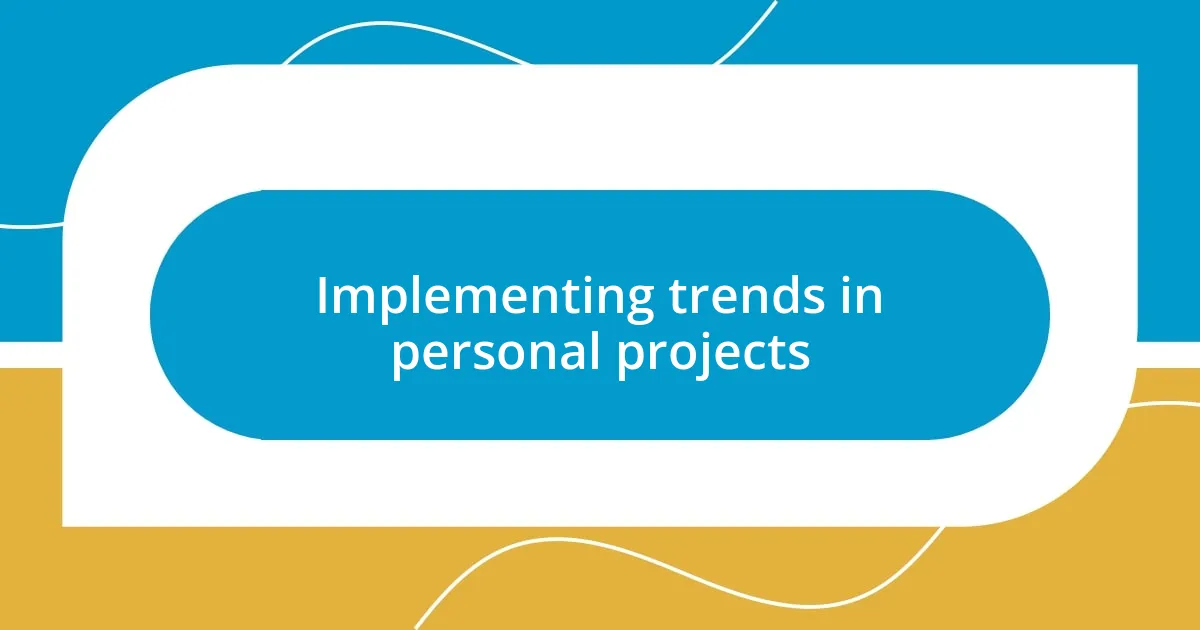
Implementing trends in personal projects
Implementing design trends into my personal projects can feel like an exhilarating adventure. I remember deciding to feature a minimalist aesthetic in a recent website redesign. It was such a satisfying challenge to strip away unnecessary elements, showcasing how clean lines and open spaces could create a more engaging user experience. Have you ever felt the thrill of clarity hewn from chaos? That’s what embracing minimalism did for me—it cleared the clutter, allowing the core message to shine.
Another trend I’ve recently experimented with is incorporating sustainable design principles into my work. I once undertook a project that focused on eco-friendly materials and processes. The sense of purpose I felt while researching alternative resources was profound—using organic textures gave my designs an authenticity that resonated with my values. Have you felt that connection when aligning your work with something important to you? It truly enriches the creative process.
I also like to keep an eye on color trends, and this often leads me to update my personal projects. Recently, I opted for a color palette inspired by botanical themes, which instantly breathed life into a branding project. It’s fascinating how colors can evoke emotions and convey messages. Can you recall a time when a color choice made all the difference in your design? For me, that choice infused my project with warmth and vibrancy, leaving a lasting impression on clients and audiences alike.
